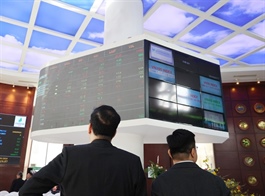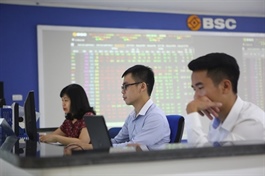Bank stocks face cautious optimism as VN-Index eyes year-end recovery
Bank stocks face cautious optimism as VN-Index eyes year-end recovery
Despite strong profit growth and record credit expansion, cautious sentiment persists towards bank stocks, as investors weigh risks and earnings quality in Vietnam’s anticipated year-end market rebound.
According to its latest financial report released on October 14, VPBank posted a consolidated pre-tax profit of $815.8 million for the first three quarters of 2025, up 47.1 per cent on-year. In Q3 alone, the bank reported a record $366.6 million in pre-tax profit - a 76.7 per cent surge, marking its highest quarterly result in the past 15 quarters.
After nine months, VPBank’s profit has already surpassed its full-year 2024 results, fulfilling 81 per cent of its 2025 target.
LPBank also delivered robust results, with cumulative pre-tax profit for the first nine months of 2025 reaching $384.5 million, up 9 per cent on-year. The main driver came from Q3, when pre-tax profit hit $138 million, up 15.3 per cent compared to Q2.
|
The results not only highlight stable growth momentum but also demonstrate stronger operational efficiency, laying a solid foundation for further acceleration in Q4.
At SHB, its Q3 pre-tax profit reached $134.4 million, showing a staggering 54.6 per cent jump from a year earlier. Cumulatively, SHB recorded $492.3 million in pre-tax profit for the first nine months, up 36 per cent on-year, completing 85 per cent of its annual plan.
Meanwhile, MBBank posted a pre-tax profit amounting to $925.6 million for the first nine months of 2025, up nearly 12 per cent on-year and fulfilling 73 per cent of its yearly target.
The bank’s cost-to-income ratio improved to 27.9 per cent, down 2.34 percentage points from the same period last year, creating room to further reduce lending rates in line with government policy.
Of note, in October, when most companies disclosed their Q3 and nine-month business results, despite positive earnings reports, stocks in the VN30 basket and bank tickers showed weaker performance compared to the broader market.
Commenting on this, Le Hoai An, a certified analyst and founder of Integrated Financial Solutions and Services, said that while many banks reported seemingly impressive Q3 profits, the market appeared to be sending a more cautious message.
“Investors are not just looking at the percentage growth figures; they’re also examining the quality of earnings, sustainability of profits in upcoming quarters, and associated risks. When underlying fundamentals have yet to improve significantly, price corrections are understandable,” An noted.
He explained that the first factor is net interest margin. During the second quarter, listed banks’ average margin stood slightly above 3 per cent, significantly lower than a year ago and still on a declining trend.
Financial statements from banks have not all been released, but preliminary data indicate that the trend in net interest margin has yet to show improvement in Q3.
The second factor, according to An, is provision expenses, which have shown signs of rising at some banks. In certain cases, while net operating profit rose by over 20 per cent, provisioning costs more than doubled, keeping pre-tax profit flat or slightly down.
"This reflects a lag effect of bad debt, particularly in consumer lending and real estate segments, following a difficult period," An explained.
The third concern, An said, involves legal and news-related risks surrounding bond issuances, which have partly affected investor sentiment.
“The market is signalling prudence,” An said. “It’s calling for stronger fundamentals, tighter credit risk control, and greater clarity on legal issues. The current correction phase is a necessary test to distinguish banks with truly solid financial health.”
Tran Thi Khanh Hien, head of Research at MB Securities, noted that since the outset of the year, the banking sector has been among the strongest performers.
The banking index has climbed more than 26 per cent, contributing to the 33 per cent rally in the VN-Index.
“The stock market reflects investor expectations for the next few quarters,” Hien said. “Therefore, it’s understandable that the strong rally in bank stocks from June to August has already priced in much of the positive Q3 earnings results.”
According to data from the State Bank of Vietnam, as of September 29, credit growth had reached 13.4 per cent compared to the end of 2024 – nearly 1.5 times higher than the same period last year at 9.1 per cent and the strongest pace in the past five years. This acceleration comes as the central bank continues to maintain an accommodative monetary policy to support economic growth.
“With the government targeting GDP growth of over 8 per cent in 2025 and above 10 per cent in 2026, credit growth is expected to reach 19–20 per cent during this period. Based on these projections, we estimate that the banking sector’s overall profit could rise by approximately 22 per cent in 2026, outpacing this year’s growth of 16–17 per cent,” said Hien.
“From a valuation perspective, the sector’s average 2026 price-to-book ratio stands at just 1.5x, about 12 per cent lower than its 2025 peak. Therefore, I believe that the VN-Index’s recovery in the final months of this year will most certainly feature bank stocks as a key driver,” she added.
- 18:25 31/10/2025

























